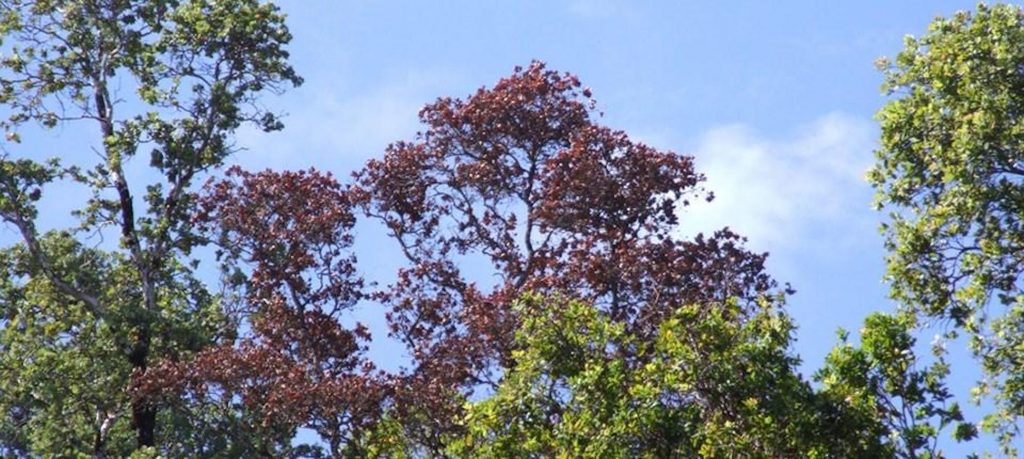Rapid ʻŌhiʻa Death Linked to Hoofed Animals in UH Hilo Research
New findings reveal the spread of a fungal disease killing off hundreds of thousands of mature ‘ōhi‘a trees on Hawai‘i Island could be exacerbated by the presence of ungulates or animals with hooves.
A geographer at the University of Hawai‘i at Hilo, along with colleagues from the National Park Service, US Forest Service and US Department of Agriculture, published a collaborative study that examines the link between the disease known as rapid ‘ōhi‘a death (ROD) and ungulates such as feral pigs.
The researchers discovered the number of suspected ROD trees in unfenced areas was significantly higher (more than 50 times greater for one location) than those found in fenced areas that prevent hoofed animal access.
The study’s co-authors collected field samples and conducted laboratory testing using data from impacted areas within Hawaiʻi Volcanoes National Park (HVO) and the Laupāhoehoe Forest Reserve. The spatial patterns of ‘ōhi‘a mortality observed across all four sites included in the study showed significant differences in areas with and without ungulates, suggesting that ungulate exclusion is an effective management tool to lessen the impacts of ROD in forested areas in Hawai‘i.
An unexpected event at one of the study sites showed the impact feral pigs caused after they breached a fenced area. Suspect ROD tree densities in the area rose from practically none to nearly three trees per hectare (nearly 2.5 acres) highlighting the need for ungulate control.
“The results from this work show us that the impacts of ROD can vary across the landscape,” said the Lead investigator of the study, Ryan Perroy, an associate professor of geography and environmental science at UH Hilo. “We hope this information can be useful in managing and caring for our native forests.”
Perroy specializes in remote sensing and was integral in obtaining aerial imagery to detect ‘ōhi‘a mortality at an individual tree level. He worked alongside a Hawaiʻi Island-based research team, which includes Timo Sullivan and Daniel Duda from the UH Hilo Data Visualization Laboratory; David Benitez, an ecologist at HAVO; Flint Hughes, an ecologist at the Institute of Pacific Islands Forestry; and Lisa Keith, Eva Brill and Karma Kissinger, plant pathologists from the Daniel K. Inouye U.S. Pacific Basin Agricultural Research Center.
“There are lots of remaining questions that still need to be addressed relating to ungulate species-specific behavior and impacts (pigs vs. goats vs sheep vs. cattle), differences between domesticated and feral animals, and lots of remaining questions regarding non-ungulate factors we think play a role in ‘ōhi‘a mortality, from boring beetles to storm events,” said Perroy.
ROD was first discovered on Hawai‘i Island in 2014 and has since obliterated hundreds of acres of once sprawling ʻōhiʻa. It is also found on Kaua‘i, Maui and O‘ahu. The deadly disease is caused by two invasive fungi, Ceratocystis huliohia and Ceratocystis lukuohia, and, if left unstopped, could irreversibly change Hawaiian ecosystems and cultural traditions by diminishing the keystone native tree in Hawaiian forests.









